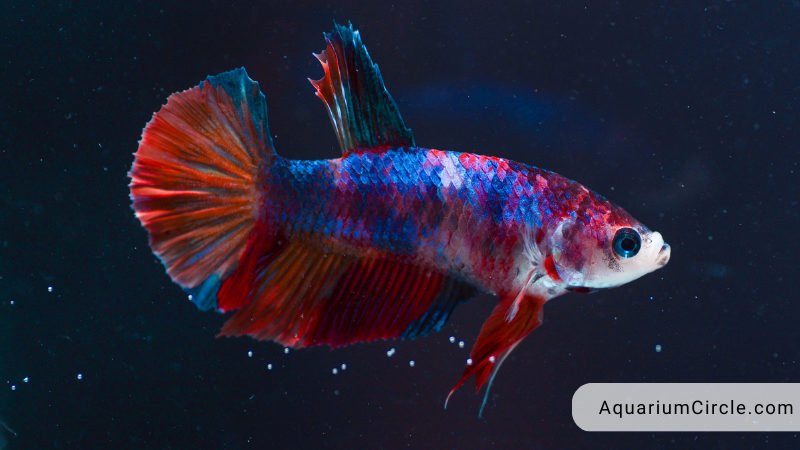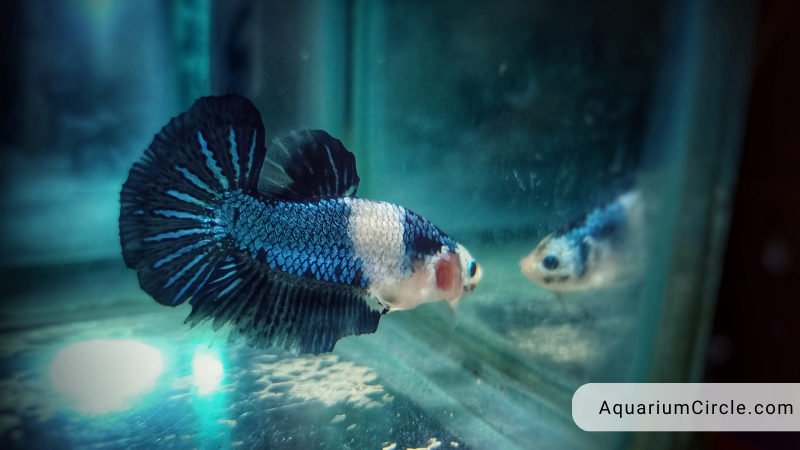Betta fish, also known as Siamese fighting fish, have captured the hearts of aquarium enthusiasts around the world with their vibrant colors and flowing fins. As captivating as these freshwater fish are, one question often arises among pet owners and potential Betta fish keepers: “How big do Betta fish get?” Understanding the size of Betta fish is essential, as it helps you provide a suitable environment, select compatible tank mates, and maintain the overall health of your aquatic companion.
In this post, let’s figure out together about how big do Betta fish get, what are their size when they have fully grown and some tips that can help your Betta fish reach the maximum growth.
See also:
- 5 Most Expensive Betta Fish In The World
- Betta Fish Tank Size: Are You Considering The Best Tank Size For Betta Fish?
- Betta Fish Full Moon: Ultimate Care To Expand The Lifespan
How Big Do Betta Fish Get? (Average Size)
Betta fish, scientifically known as Betta splendens, typically reach an average size of 2.5 to 3 inches (6.35 to 7.6 cm) in length, not including their fins. However, their size can vary depending on factors such as genetics, diet, and environment. Males are generally larger and have longer fins than females, who tend to be slightly smaller with shorter fins.
It’s important to note that there are different types of Betta fish, such as Plakat, Veiltail, Crowntail, and Halfmoon, which may exhibit some variation in size and fin length. While their body size may be similar, their fin length and overall appearance can vary significantly.
How Big Do Bettas Get? (Maximum Size)

The maximum size of Betta fish can vary depending on factors such as genetics, diet, and living conditions. Generally, domesticated Betta fish can reach up to 3 inches (7.6 cm) in body length, not including their fins. In some cases, exceptionally large Betta fish may grow larger a bit, around 3.5 inches (8.9 cm), but this is relatively rare.
Factors affecting Betta fish growth
Several factors can influence the growth of Betta fish, impacting their overall size and development. These factors include:
- Genetics: Genetics play a significant role in determining the size of a Betta fish. Different breeds and strains of Betta fish can have different size potentials. Wild Betta fish species may also have different size ranges compared to their domesticated counterparts.
- Diet: The quality and quantity of food provided to Betta fish can significantly impact their growth. A nutrient-rich diet that includes high-quality Betta pellets, live or frozen foods like brine shrimp, daphnia, and bloodworms will provide the necessary nutrients for healthy growth. Overfeeding, on the other hand, can lead to health issues and stunted growth.
- Environment: The living conditions of a Betta fish can greatly influence their growth. Factors such as tank size, water quality, and temperature all play a role in supporting or hindering growth. A small or overcrowded fish tank may limit growth potential, while poor water quality and inappropriate temperature can cause stress and health issues, impacting growth.
- Water Quality: Maintaining proper water parameters, including pH, ammonia, nitrite, and nitrate levels, is crucial for Betta fish growth. Poor water quality can lead to stress, illness, and stunted growth.
- Tank Size: Although Betta fish can survive in small spaces, providing a larger fish tank (ideally at least 5 gallons for a single Betta) with ample swimming space can encourage healthier growth.
- Stress: Stressful conditions, such as aggressive tank mates or frequent environmental changes, can have a negative impact on Betta fish growth. Stress can lead to a weakened immune system, making them more susceptible to illness and stunting their growth.
By understanding and addressing these factors, you can create a supportive environment for your Betta fish, allowing them to reach their full growth potential and live a healthy life.
See also: Betta Fish Natural Habitat: Where Do Betta Fish Come From And How Do They Live In Wild Environment?
How Big Can A Baby Betta Fish Get?

Baby Betta fish, also known as fry, start out very small, measuring just a few millimeters in length. As they grow and develop, baby Bettas will eventually reach their adult size. The size of a fully-grown Betta fish typically ranges from 2.5 to 3 inches (6.35 to 7.6 cm) in length, not including their fins. In some rare cases, they can grow slightly larger, up to around 3.5 inches (8.9 cm).
During the first few weeks of their lives, Betta fry grow rapidly and require proper care, including a nutrient-rich diet and stable water conditions, to support their development. As they reach the juvenile stage, their growth rate will slow down, and they will continue to grow until they reach their adult size within 6 to 12 months.
The final size of a baby Betta fish depends on factors such as genetics, diet, and environment. Providing a healthy environment with a balanced diet and suitable living conditions will ensure optimal growth for your Betta fish.
See also: How To Breed Betta Fish At Home? Detailed Step-by-step Guide For You
Betta Fish Size Myth: Betta Fish Grow To The Size Of Their Tank
There is a common misconception that Betta fish will grow to the size of their tank. This myth likely stems from the observation that fish in small tanks often appear stunted or smaller than their potential size. However, the size of a Betta fish is primarily determined by genetics, diet, and overall health, rather than the size of their tank.
While tank size does play a role in the overall well-being of a Betta fish, it doesn’t directly dictate their growth potential. Keeping a Betta fish in a small tank may lead to stress, poor water quality, and limited swimming space, all of which can negatively affect their health and growth. In contrast, a larger tank with proper water quality and temperature will help support healthier growth and a more robust immune system.
Others common misconceptions about Betta fish size?
Another misconception is that overfeeding promotes growth. In reality, overfeeding can lead to health issues such as obesity, swim bladder disorder, and a weakened immune system, which can hinder growth rather than promote it. A balanced diet and proper feeding schedule are essential for healthy growth.
Some people believe that all Betta fish grow at the same rate. However, growth rates can vary depending on factors such as genetics, diet, and environmental conditions. Some Betta fish may reach their full size faster than others, and different types of Betta fish may have varying growth patterns.
It’s also commonly thought that Betta fish keep growing throughout their lives. Betta fish typically reach their full size within 6 to 12 months. While they may continue to grow slowly after reaching adulthood, their growth rate will be significantly slower, and they will not continue to grow indefinitely.
Lastly, there is a misconception that male Bettas and female Bettas are the same size. In fact, male Betta fish are generally larger and have longer fins than females, who tend to be slightly smaller with shorter fins. It’s essential to understand these differences when caring for Betta fish and selecting appropriate tank mates.
By dispelling these misconceptions and understanding the factors that truly influence Betta fish growth, you can provide the proper care and environment to ensure your Betta fish reach their full growth potential and maintain good health.
How Can You Help Your Bettas Get To Full Size?

To support optimal Betta fish growth, it’s essential to provide an environment that promotes their overall health and well-being. Here are some tips to help you ensure your Betta fish reaches its full potential:
- Proper tank size: Provide a tank with a minimum capacity of 5 gallons for a single Betta fish. A larger tank offers more swimming space and helps maintain better water quality, which contributes to their overall health and growth.
- Maintain water quality: Regularly check and maintain water parameters, including pH, ammonia, nitrite, and nitrate levels. Perform partial water changes (20-25% of the water) every week to maintain water cleanliness and stability.
- Provide a heater and thermometer: Betta fish are tropical fish and thrive in water temperatures between 76 and 80°F (24 to 27°C). Use an aquarium heater and thermometer to maintain a stable temperature in the tank.
- Offer a balanced diet: Feed your Betta fish a varied diet that includes high-quality Betta pellets and occasional live or frozen foods like brine shrimp, daphnia, and bloodworms. This variety ensures they receive the necessary nutrients for healthy growth.
- Maintain a proper feeding schedule: Overfeeding can lead to health issues and hinder growth. Feed your Betta fish once or twice a day, offering an amount they can consume within a couple of minutes. Remove any uneaten food to prevent water pollution.
- Provide hiding spots and plants: Betta fish benefit from having hiding spots and plants in their tank, which can help reduce stress and promote a sense of security. Use live or silk plants and aquarium-safe decorations to create a comfortable environment.
- Monitor tank mates: If you have other fish or creatures in the tank with your Betta, ensure they are compatible and peaceful. Incompatible or aggressive tank mates can cause stress, which can negatively affect your Betta fish’s growth and health.
- Regularly check for signs of illness: Monitor your Betta fish for any signs of illness or stress, such as lethargy, loss of appetite, or changes in color. Promptly address any health concerns to prevent complications that could affect growth.
By following these tips, you can create an environment that encourages healthy growth for your Betta fish and helps them reach their full size potential.
See also: Betta Fish Toys – 17 Best Betta Fish Toys For A Joyful Life
Video About How Big Do Betta Fish Get
FAQs
How big do most Betta fish get?
Most Betta fish grow to an average size of 2.5 to 3 inches in length, not including their fins. However, size can vary depending on factors such as genetics, diet, and environment.
How long does it take for a Betta fish to reach its full size?
Betta fish typically reach their full size within 6 to 12 months, but their growth rate may vary depending on factors such as diet, water quality, and genetics.
Do male and female Betta fish differ in size?
Yes, male Betta fish are generally larger and have longer fins than females. Females tend to be slightly smaller and have shorter fins.
Does tank size affect how big a Betta fish will get?
Tank size can have an impact on Betta fish growth, but it is not the only factor. A larger tank with proper water quality and temperature will help support healthier growth, but genetics and diet also play a role.
What is the ideal tank size for a Betta fish?
A minimum tank size of 5 gallons is recommended for a single Betta fish. Providing a larger tank with proper filtration, heating, and hiding spots will help ensure your Betta’s overall health and well-being.
References

Annette M. Chaney is an experienced marine biologist with over 20 years of experience as an aquarist and fishkeeper. She started her first aquarium at a young age, filling it with frogs and goldfish obtained from the ten-cent pet store.
Annette grew up caring for and breeding African Cichlids, which led to a hobby in high school that doubled as a profitable means. Attending Reed College gave her time to solidify herself as an accomplished aquarium caretaker with an eye for sales. After that, from 2009 – 2013, she studied at Roger Williams University – one of the most prestigious universities for Aquaculture and Aquarium in USA. She is the founder of AquariumCircle since 2010.
